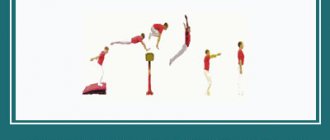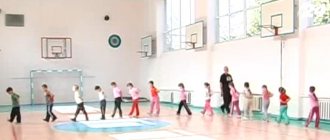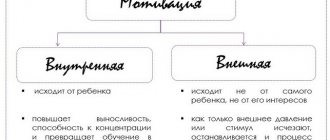“Golden rules” of fitball gymnastics:
Each child needs to select the ball according to their height, so that when they sit on the ball, there is a right angle between the body and the thigh, the thigh and the lower leg, the lower leg and the foot. Correct posture also includes a raised head, lowered and separated shoulders, an even position of the spine, and a tucked stomach.
- Before playing with balls, you should make sure that there are no sharp objects nearby that could damage the ball.
- Wear children comfortable clothes that do not interfere with movement and non-slip shoes.
- Start with simple exercises and easier starting positions, gradually moving to more complex ones.
- No exercise should cause pain or discomfort.
- Avoid fast and sudden movements, twisting in the cervical and lumbar spine, intense tension in the muscles and back.
- When performing exercises lying on the ball, do not hold your breath.
- When performing exercises on the ball while lying on your stomach and lying on your back, your head and spine should form one straight line.
- When performing exercises, the ball should not move.
- Physical activity should be strictly dosed in time in accordance with the age capabilities of the children.
- Monitor the technique of performing exercises, follow belay techniques and teach self-belay during class with balls.
- In each lesson, it is necessary to strive to create a positive emotional background, a cheerful, joyful mood.
- It is possible to conduct complex classes where, simultaneously with physical exercises, children improve their speech culture and correct pronunciation.
- Exercises on balls in order to develop communication skills in children can be performed in paired general developmental exercises, outdoor games, and team competitions. You should pay special attention to signs of physical distress in the child, and if they appear, it is necessary to reduce the load or stop the activity for a while.
Mechanisms of the physiological effects of fitball exercises on the child’s body
In the practice of sports, pedagogy and medicine, considerable experience has been accumulated in the use of balls to solve health and sports problems.
Large-diameter balls - fitballs - appeared relatively recently and have already gained wide popularity. Fitball translated from English means a ball for support, used for recreational purposes.
Motor activity is a powerful biological stimulator of the vital functions of a growing organism. A new form of physical education and posture correction for children is fitball gymnastics.
Fitball gymnastics is performed on large multi-colored balls that can support weights of up to 300 kg. In this case, the ball can be used as a training device, as an object and as a weighting agent (its mass is approximately 1 kg).
In classes, fitballs of various diameters are used, depending on the height and age of the students. For children 3-5 years old, the diameter is 45 cm, from 6-10 years old - 55 cm. The ball is selected correctly if, when landing on it, the angle between the thigh and shin is equal to or slightly more than 90°. For activities with preventive and therapeutic purposes, as well as for activities with preschool children, the ball should be less elastic.
Balls can be not only of different diameters, but also of different colors. Warm colors (red, orange) increase the activity of the autonomic nervous system. They also stimulate and tone up the immune system, strengthen memory and vision, give vigor, and improve skin color.
Cool colors (blue, cyan) normalize cardiac activity and worsen speed and strength qualities.
Green color normalizes cardiac activity and the central nervous system, stabilizes blood pressure, relaxes, relieves tension, helps with diseases of the spine, metabolism, and migraines.
The color design of the room in which children engage in physical exercises and educational games is significantly different from the rooms where children relax. The interior of a playroom or gym, made in bright colors and equipped with sports equipment, will stimulate the creative and playful activity of children.
In addition to the color effect on the human body, fitballs also have a vibration effect. Mechanical vibration actively stimulates the functioning of all human organs and systems. Continuous vibration has a calming effect on the nervous system, while intermittent vibration has a stimulating effect. In classes with children, light vibration is used at a calm pace (sitting, without lifting the buttocks from the ball). Vibration, similar to horse riding, is used in the treatment of osteochondrosis, scoliosis, diseases of the gastrointestinal tract, coronary heart disease, obesity, and neurasthenia. When sitting on a fitball, the ischial tuberosities and sacrum have the greatest contact with it. Through the sacrum, rhythmic vibrations spread throughout the entire spine.
Therefore, just the correct landing on the fitball already contributes to the formation of the skill of correct posture. Correct landing on the fitball aligns the oblique position of the pelvis, which is important for correcting scoliotic deviations in the thoracolumbar spine. Performing exercises in the starting position lying on your stomach or back is much more difficult than on a stable support. Maintaining balance involves numerous muscle groups in coordinated work, solving the problem of forming a muscle corset by strengthening the back and abdominal muscles.
Stages of children mastering exercises using fitballs
1st stage.
Objectives of the stage and their implementation.
1. Give an idea of the shape and physical properties of fitball.
Recommended exercises:
- various rolling of the fitball on the floor, on the bench, between landmarks in a “snake” pattern, around landmarks;
— hitting a fitball with both hands on the spot, in combination with various types of walking;
- passing the fitball to each other, throwing the fitball;
- games with fitball: “Catch the ball”, “Hit the target with the ball”, “Dodgeball”, “Get the ball” (options: push with your palms; push with your outstretched foot).
2. Teach how to sit correctly on a fitball.
Recommended exercises:
— sitting on a fitball against a solid support, check that your feet are positioned correctly (your feet should be pressed to the floor and parallel to each other);
— sitting on a fitball, perform exercises for the shoulder girdle at a slow pace.
For example:
a) turning the head left and right;
b) alternately raising the arms forward, up and to the side;
c) raising and lowering the shoulders;
d) sliding hands along the surface of the fitball;
e) bending the arms to the shoulders, clenching the hands into fists, arms to the sides;
f) at the signal, stand up and run around the ball, holding it with your hand.
3. Teach basic positions when performing exercises on the ground (sitting, lying, squatting).
Recommended exercises:
— Sitting in a half-squat on your toes, facing the fitball, straight arms on the fitball, knees to the sides, back straight.
We perform from a standing position facing the ball: 1-2 squatted, checked the position; 3-4 stood up, arms to the sides. At a signal, everyone scattered and ran between the fitballs; at another signal, they ran up to their fitballs and sat down.
This position can be taken in pairs with one fitball facing each other.
I.p. - stand on your knees facing the fitball, hands on the fitball;
sit on your heels, press the fitball to your knees;
return to the starting position.
I.p. - lying on your back on the floor, straight legs on a fitball, resting on your heels. Swing the fitball with your feet left and right, arms along your body. This exercise can be done in pairs with one fitball, positioned in a mirror position.
I.p. - lying on your back on the floor, legs straight on a fitball. Raise your pelvis off the floor. Can be performed simultaneously in pairs, positioned in a mirror manner.
I.p. - lying on your back on the floor, feet on a fitball. Take small steps on the surface of the fitball back and forth.
Transitions from a sitting position, a fitball on straight legs, rolling the fitball to your chest, lie on your back. Return to the starting position in a similar way.
I.p. — lying on your back on the floor, clasp the fitball with your legs. Bend your knees and squeeze the fitball. You can do it two at a time. The same in a sitting position.
I.p. - lying on your back on the floor, legs bent at the knees, lying on a fitball, hands behind your head. Raise your upper body towards your knees. Can be done by two people at the same time.
I.p. - lying on your back on the floor, straight legs together, arms extended behind your head, fitball in your hands. Pass the fitball from hands to feet and vice versa.
Kneeling on the floor facing the fitball, straightening your legs, roll into a position on your stomach on the fitball. Legs and arms rest on the floor. It is better to start this exercise with a fitball, the diameter of which is one size smaller than that required for children practicing.
Lying on your back on the floor, legs bent at the knees on a fitball. Tightening your leg muscles, press the fitball to your buttocks.
Ball games for preschool children
Ball school for preschoolers
Author : Yulia Viktorovna Butova, physical education instructor, teacher at MKDOU kindergarten No. 6 “Yagodka”, Kirov, Kaluga region. Description : this material will be useful to kindergarten teachers and physical education instructors.
I bring to your attention the tasks of physical education, recommendations from the teacher and games with balls, a methodological development called “Ball School”
Goal : To develop children's interest in playing with the ball. Objectives of physical education : When rolling balls, push them energetically with your hands. Catch the ball with your hands, without pressing it to your chest. Develop the ability to throw the ball with both hands. Develop manual dexterity. Introduce children to the shape, volume, and properties of a rubber ball. Learn to calmly and clearly perform exercises with the ball. Learn to throw a small ball at a target. Learn to hit the ball vigorously with your wrist. Learn to catch the ball with both hands. Teach general developmental exercises with large balls. Develop skills in catching and passing a big ball to each other. Learn to hit a hanging basket with a large ball. Practice rolling the ball with your feet between objects and towards each other. Improve the accuracy of passing the ball to each other from below, from behind the head, from the chest.
Methodical recommendations: Children love playing with the ball, so they should be given the opportunity to feel the nature of the ball and show independence while moving with the ball. When performing exercises with the ball, pay attention to each child. Find words of approval in a timely manner that allow the child to easily perform movements; due to the heavy load during the lesson, pay special attention to active rest intervals: children can freely play with the ball, as if preparing for subsequent motor tasks. Exercises prior to throwing at a target are necessary for young children. The child’s hand gradually gets used to the ball, movements become more confident, and hand work is especially important. In younger groups, it is necessary to constantly play out actions with the ball: “a small ball is easy,” “the ball can run away - it’s playing with you.” While performing the exercises, the teacher constantly comments on the children’s actions and movements and corrects them, especially if these actions are monotonous. When throwing the ball on the floor, it is advisable to draw the children’s attention to the movement of the ball, what it does, and then to the actions of the children with the ball. Do not ignore those children who were unable to complete the task; you should work with them individually and help them develop motor memory. Follow the “ball resting” technique, which allows the child to get a short break, a change of movements occurs, and attention is switched to another action. When throwing the ball into the distance, children should be shown how to take the correct starting position (legs wider, one leg in front, torso tilted forward when swinging). The movement of the wrist is an important element in throwing, show how the movement is performed, compare it with the moment of the position of the hand during farewell, when we say “goodbye”. When throwing the ball with both hands, pay attention to the technique of throwing the ball on the ground and then catching it. It is very important to teach your child to regulate the force of repulsion: to push the ball not only with force, but also with less effort, without moving it far from the chest. If rolling the ball with your feet to each other and between objects does not work (this is difficult), you can invite the children to try rolling the ball between objects without passing it to each other. Movements (tasks) are changed in subgroups after everyone has completed this task the specified number of times. Avoid unreasonable lengthy explanations while performing tasks and exercises. When throwing the ball to each other, remind the children that they must be careful when receiving the ball - the one who catches does not stand motionless in place, but correctly calculates the flight and catches the ball. Encourage children to have good control over the movement of the ball and the ability to gently push it away with their fingers. Children learn the technique of passing the ball gradually, so you shouldn’t rush them too much; in the process of learning to pass the ball, it is necessary to remind children that: - elbows should be lowered near the body; - try to throw the ball at the level of your partner’s chest; - follow the ball with your gaze and a certain position of your hands. When learning to throw a ball into a basket from a standing position, you need to pay attention to the fact that children throw the ball while standing in the correct stance, take aim, follow the ball with their eyes, and do not spread their elbows to the sides. Celebrate any successes of children. The interest of children in classes depends on the teacher; it is important to maintain it throughout all moments and even when comments are made on improving movements. When practicing with a ball and a jump rope, the teacher should work only with half the group. Only in this case can children gain skills and abilities, and the instructor can individually control each child (seven to eight children); the rest of the children must work with another adult (teacher) and with a different content of tasks (repetition and consolidation of previously familiar movements and actions). Here are some interesting ball games
:
“Ball up”
Game description
: The driver is selected using a counting table.
Children stand in a circle close to each other, the driver goes to the middle in the circle outlined for him, and throws the ball up after the words: “Ball up!” At this time, the players try to run as far as possible from the center of the circle. The driver catches the ball and shouts: “Stop!” All players must stop, and the driver, without leaving his place, throws the ball at the one who is closest to him. The stained player becomes the driver. If the driver misses, then he stays and plays the game again. Rules of the game
: The driver throws the ball as high as possible and only after the words: “Ball up!” The driver is allowed to catch the ball even after it bounces off the ground. If the driver drops the ball or the ball goes away, then before shouting “Sing!”, he needs to catch the ball and return to his place. If one of the players after the word “Stop!” continues to move, then he must take three steps towards the driver. When running away from the driver, players should not hide behind trees and buildings.
“Flying ball”
Game description
: Players stand in a circle, the driver is in the middle of the circle (he is selected by a counting rhyme).
At the signal, the children throw the ball to each other through the center of the circle. The driver tries to hold the ball, catch it or touch it with his hand. If he succeeds, then he stands in a circle, and the one to whom the ball was thrown becomes the driver. Rules of the game
: Players are allowed to move when catching the ball. Players must not hold the ball. The driver cannot touch the ball when it is in the player's hands.
“Ball Race”
Material
: To play the game you need two balls of different colors.
Game description
: Children stand in a circle at a distance of one step from each other, facing the center, counting on the first and second numbers.
So they are divided into two teams. In each group, a leader is selected by counting. They should stand on opposite sides of the circle. At the signal, the presenters begin to throw the ball only to the players of their group, in one direction. The group in which the ball returned to the leader first wins. Children choose another leader. The game is repeated, but the balls are thrown in the opposite direction. By agreement, the game can be repeated 4 to 6 times. Rules of the game
: The presenters must start the game at the same time upon a signal. The ball is only allowed to be thrown. If the ball falls, the player who dropped it picks it up and continues the game. Players must throw the ball accurately and be careful when receiving the ball: the one who catches should not stand motionless and wait for the ball to fall into their hands. You need to keep an eye on the ball and, if necessary, take a step forward.
“Roll, merry ball”
Description of the game:
Children line up in a circle at arm’s length.
The players pass the ball around in a circle with the words: You roll, funny ball, Quickly, quickly through the hands, Whoever has stopped runs to the sides!
The player who still has the ball in his hands turns his back to the center.
The players standing on both sides of him turn to the sides and run at the signal: “One, two, three - run!” Whoever runs to the ball first takes it, and the game starts over. Now, you can pass the ball in a different direction. Rules of the game
: Players must quickly and accurately pass the ball to each other.
The driver cannot deliberately hold the ball for another player. Players must run in different directions, back to back to each other. You need to run around the circle, and you cannot run into the game Description:
All players, except the driver, stand in a circle and throw the ball to each other, calling by name the one who must catch it.
The driver stands in the middle of the circle and tries to hit the ball flying above him with his hand. As soon as the ball thus detained falls to the ground, the players scatter, and the driver quickly picks up the ball and, shouting “Stop!”, tries to mark one of the players. The stained player becomes the driver. If the driver misses, then he goes back to the circle to drive. Rules of the game:
Players must quickly and accurately pass the ball to each other. The driver only stops the flying ball. The driver spots the players from the place where he picked up the ball.
“Watchmen”
Material:
Small balls according to the number of children.
Description of the game:
Participants in the game stand in a circle at a distance of one step.
All players have small balls. A city is built in the middle of the circle (pins placed at a distance so that a small ball can pass freely between them). The town is guarded by three watchmen (selected by a rhyme). Players, standing in one place, kick the ball into the town. The one who, by rolling the ball, knocks down the pin, takes the place of the guard. Rules of the game:
Players must only roll the ball. You cannot let the ball hit by the guard go beyond the circle; the one who missed the ball leaves the game. Watchmen are allowed to move from one side to the other while protecting the city. The guard holds and kicks the ball only with his foot.
“Bunny”
Game description:
A large circle is drawn on the site.
The Bunny is chosen as a counting table, he goes into a circle, and all the players stand behind the circle. They throw the ball to each other, but so that it hits the player - the bunny. The bunny runs in a circle, dodging the ball. The one who stains the bunny player takes his place in the circle. Rules of the game:
Players must not go beyond the boundaries of the circle. Before passing the ball, you need to call by name the person who is supposed to catch it. You need to pass the ball quickly, you cannot hold it in your hands. The faster the players pass the ball, the more interesting the game is. The bunny player can, if desired, catch the ball. In this case, the player whose ball was caught stands in a circle and becomes a bunny.
“Meeting”
Material:
Large balls according to the number of players.
Chips for rewarding. Description of the game:
Two lines are drawn on the court at a distance of 4-6 meters.
Players are divided into two teams with an equal number of players and stand opposite each other behind the lines. At the signal, everyone rolls the balls at the same time, but so that they meet. The instructor gives a chip to the players in a pair whose balls meet. The pair with the most chips at the end of the game wins. The number of repetitions of the game takes place at the request of the players. Rules of the game:
The area where the game is played must be level. You need to increase the distance between players gradually. Children need to be told that the greater the rolling distance, the more energetic the ball should be pushed.
We recommend watching:
Outdoor games for preschool children Games for younger preschoolers on the topic Animals Organization and conduct of outdoor games in various types of activities Outdoor games with elements of role-playing games for children 4-6 years old
Similar articles:
What is a plot-based role-playing game?
Outdoor games for children aged 1, 2, 3 years
Outdoor game for children “Birds of Migratory”
Outdoor games for children 3-4 years old in kindergarten
Outdoor games for preschoolers in kindergarten







